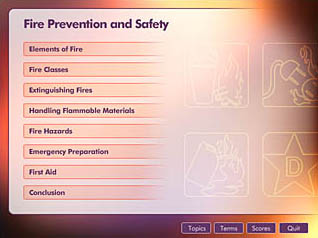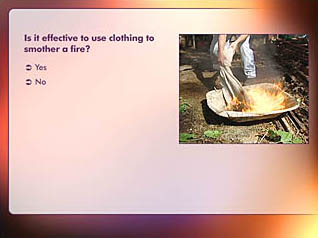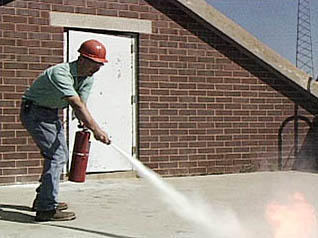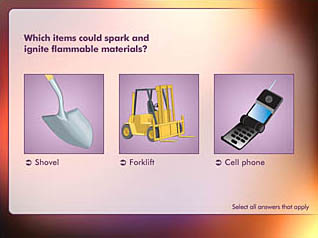Fire: Fire Prevention Safety

- Product ID
- smaxfpsa
- Training Time ?
- 68 to 136 minutes
- Language(s)
- English
- Video Format
- Standard Definition
- Required Plugins
- MasteryNet Player
- Lesson Interactions
- 19
- Quiz Questions
- 41
- Closed Captioning



Online Fire Safety Training course
In this fire safety training course your workers will learn the four elements required for a fire. They will learn the different classes of fires. In this fire safety training course, your workers will learn how to choose the right fire extinguisher and how to extinguish a fire using the PASS method. Your workers will learn about the causes of fires and how to properly store flammable, combustible, and reactive materials. Other hazards are covered such as cutting, welding, and electrical hazards. This fire safety training also thoroughly covers emergency procedures and the importance of preparation.
![]() This course is in the Advantage™ format, to read about Advantage™ features click here.
This course is in the Advantage™ format, to read about Advantage™ features click here.

- Rich multimedia presentation with interactions and quiz
- Print certificate and wallet card
- You have 30 days to complete the course
Fire safety training is required for all employees.
-
Elements of Fire
- Fire elements
- Heat
- Fuel
- Oxygen
- Flashpoint
-
Fire Classes
- Determining fire classes
- Class A fires
- Class B fires
- Class C fires
- Class D fires
-
Extinguishing Fires
- Using the right extinguisher
- Putting out a fire
- The P.A.S.S. method
- How long fire extinguishers last
-
Handling Flammable Materials
- Causes of industrial fires
- Storing flammable liquids
- Spontaneously combustibles
- Shock-sensitive materials
- Reactive materials
-
Hazards
- Static Electricity
- Sparking tools and equipment hazards
- Welding and cutting hazards
- Electrical hazards
- Smoking Hazards
-
Emergency Preparation
- Fire alarms and smoke detectors
- Emergency Action Plan
- Evacuation
- Reporting area
- Using doors during a fire
- Staying away from smoke
- STOP, DROP, and ROLL
-
First Aid
- Treating serious burns
- Treating minor burns
- Treating smoke inhalation
-
Recognize elements that cause fire.
- Identify the three elements that make a fire.
- List items that can generate heat.
- Choose fuel types.
-
Use caution when working with flammable materials.
- Define flashpoint.
- Differentiate between flammable and combustible materials.
- Choose activities that cause a fire to grow.
-
Identify fires by Class.
- Select class D as the most dangerous fire.
- Choose materials that cause a Class B fire.
-
Use the proper materials to put out fires.
- Select the proper material to put out a Class A fire.
- Select the proper material to put out a Class C fire.
-
Properly extinguish fires.
- Agree that the class of fire extinguisher must match the class of fire.
- List features of an automatic sprinkler system.
- Analyze actions used to extinguish fires.
- Describe the PASS fire extinguisher method.
- Recall the length of time it takes to empty a fire extinguisher.
-
Safely handle flammable materials.
- Recall the cause of many industrial fires.
- Select proper storage procedures for flammable liquids.
- Recognize the dangers of spontaneously combustible materials.
- List storage requirements for shock-sensitive materials.
- Explain the danger of water-reactive materials.
-
Eliminate potential fire hazards.
- Define static electricity.
- List items that can cause static electricity.
- Describe how static is generated.
- Explain how to control container static electricity.
- Identify the fire hazards of hand tools and equipment.
- List causes of electrical fires.
-
Weld safely.
- List safe work practices to follow when welding.
- Recall the need for the fire watch to stand guard 30 minutes after the work is finished.
-
Keep surroundings clear of fire hazards.
- Agree to never smoke around ignitable materials.
- List safe ways to extinguish a cigarette.
-
Be prepared for a fire emergency.
- Describe the areas where fire and smoke detectors should be placed.
- Recall information contained in an Emergency Action Plan.
- Each employee can identify at least two emergency escape routes.
- Restate the need to keep evacuation routes uncluttered and exit doors opened.
- Explain the procedure to follow if anyone is missing after an evacuation.
-
Follow evacuation guidelines when escaping a fire.
- List proper evacuation guidelines.
- Select procedures to check whether a door can be used during a fire.
- List procedures to follow to avoid inhaling smoke.
-
Use basic first aid for fire injuries.
- Describe burn treatment procedures.
- Select ways to help someone who has inhaled smoke from a fire.
© Mastery Technologies, Inc.



